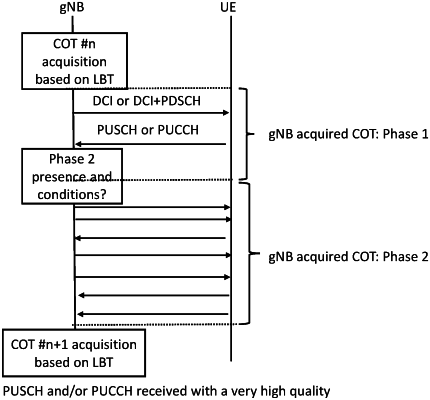| CPC B60T 8/3215 (2013.01) [B60T 8/172 (2013.01); B60T 8/1755 (2013.01); B60T 8/58 (2013.01); B62D 11/003 (2013.01); B62D 11/08 (2013.01); B62D 11/10 (2013.01); H04W 72/541 (2023.01); H04W 74/0808 (2013.01); B60T 2260/04 (2013.01)] | 18 Claims |

|
1. An apparatus comprising: at least one processor; and
at least one memory including computer program code, wherein the at least one memory and the computer program code are configured to, with the at least one processor, cause the apparatus at least to:
sense at least one beam, the at least one beam comprising a gNodeB reception beam and an associated gNodeB transmission beam;
determine that a channel on the at least one beam is idle during a listening period;
based on determining that the channel on the at least one beam is idle during the listening period, initiate a channel occupancy time based on the sensing;
transmit at least one first downlink transmission on the at least one beam during the channel occupancy time, wherein the at least one first downlink transmission on the at least one beam triggers at least one first uplink transmission on the at least one beam during the channel occupancy time;
receive the at least one first uplink transmission on the at least one beam during the channel occupancy time;
determine user equipment interference conditions on the at least one beam based on the at least one first uplink transmission, wherein the user equipment interference conditions are one of: low, high, or very high;
determine, based on the determined user equipment interface conditions, presence and conditions for scheduling opportunities for the at least one beam; and
based on the presence and conditions;
schedule at least one second downlink transmission or at least one second uplink transmission on the at least one beam with restriction during a rest of the channel occupancy time when the user equipment interference conditions meets at least one threshold requirement, wherein the restriction restricts a number and a duration of the at least one second downlink transmission or a number and a duration of the at least one second uplink transmission,
schedule at least a second downlink transmission or at least one uplink transmission on the at least one beam during the rest of channel occupancy time without restriction when the user equipment interference conditions are low;
schedule at least second downlink transmission or at least one uplink transmission on the at least one beam during the rest of channel occupancy time with restriction when the user equipment interference conditions are high; and
schedule no second downlink transmission or at least one uplink transmission on the at least one beam during the rest of channel occupancy time when the user equipment interference conditions are very high.
|